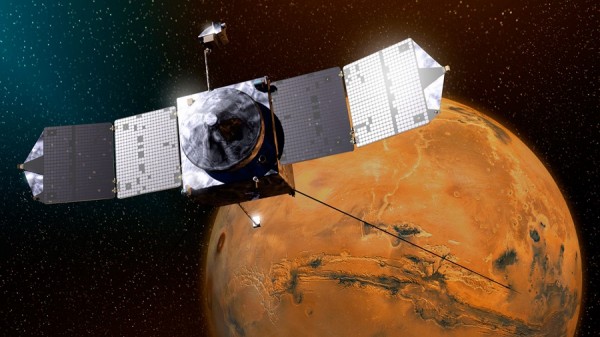By Ana Verayo, | March 05, 2017

This artist's sketch shows MAVEN above Mars. (NASA)
During a very close call like something out of a sci-fi film, NASA's Mars orbiter MAVEN was forced to change its trajectory to avoid a full on collision with Martian moon Phobos. NASA mission scientists and engineers commanded the unmanned spacecraft to fire its engines to speed up its velocity and prevent this potential disaster.
Like Us on Facebook
NASA's (Mars Atmosphere and Volatile EvolutioN) MAVEN orbiter conducted a main engine burn that boosted the orbiter's velocity by 0.4 miles per second. MAVEN was launched in November 2013 and arrived at the Red Planet in September 2014 on a mission to study Martian atmosphere specifically its ionosphere and how solar winds affect the alien world's tenuous atmosphere.
MAVEN is currently at an elliptical orbit spanning 4.5 hours with an altitude of 93 miles above the surface of Mars. Apart from this orbiter, NASA, the European Space Agency, and other space agencies also monitor the orbital paths of MAVEN including the two moons, Phobos and Deimos, for any threatening collisions.
Mission scientists of NASA's Jet Propulsion Laboratory revealed within one week's notice that MAVEN's orbit will be intersecting with the lunar orbit of Phobos. These intersections occur regularly. However, it is estimated that the spacecraft and the small moon will cross paths within several seconds of each other.
Phobos is estimated to measure 30 kilometers wide. NASA scientists have identified the chances of a potential collision between the space craft and the Martian moon. To prevent this grim scenario, mission scientists carried out commands for a main engine burn to distance MAVEN from Phobos at 2.5 minutes within each other's orbital paths. This also marks the first time that MAVEN had to complete a sudden, crucial maneuver around Mars.
According to NASA's MAVEN principal investigator, Bruce Jakosky from the University of Colorado at Boulder, NASA's JPL investigation and tracking teams were successful in monitoring all possible collisions every day of each year. Also, the MAVEN spacecraft team was able to carry out this maneuver flawlessly.
-
Use of Coronavirus Pandemic Drones Raises Privacy Concerns: Drones Spread Fear, Local Officials Say

-
Coronavirus Hampers The Delivery Of Lockheed Martin F-35 Stealth Fighters For 2020

-
Instagram Speeds Up Plans to Add Account Memorialization Feature Due to COVID-19 Deaths

-
NASA: Perseverance Plans to Bring 'Mars Rock' to Earth in 2031

-
600 Dead And 3,000 In The Hospital as Iranians Believed Drinking High-Concentrations of Alcohol Can Cure The Coronavirus

-
600 Dead And 3,000 In The Hospital as Iranians Believed Drinking High-Concentrations of Alcohol Can Cure The Coronavirus

-
COVID-19: Doctors, Nurses Use Virtual Reality to Learn New Skills in Treating Coronavirus Patients







